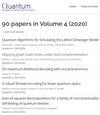使用连续变量的量子核机器学习
IF 5.1
2区 物理与天体物理
Q1 PHYSICS, MULTIDISCIPLINARY
引用次数: 0
摘要
流行的量子比特框架主导了最近关于量子内核机器学习的工作,其结果具有表达性,可学习性和泛化性。到目前为止,还没有比较的框架来理解连续变量(CV)量子计算平台的这些概念。在本文中,我们将CV量子核表示为封闭形式函数,并使用这种表示提供了几个重要的理论见解。我们推导了所有CV量子核的一般闭形式解,并证明了每个这样的核都可以表示为特征映射参数的高斯函数和代数函数的乘积。此外,在多模式情况下,我们通过量子核特征映射的“恒星等级”的分层概念,提出了所有量子核的量子经典分离的量化。然后,我们证明了由无限星阶特征映射定义的核,如gkp状态编码,可以被有限星阶特征映射定义的核任意地逼近。最后,我们用单模位移Fock状态编码模拟学习,并表明(i)我们的特定任务(环形数据集)的精度随着恒星秩的增加而增加,(ii)对于不拟合模型,可以通过增加带宽超参数来提高精度,以及(iii)对于过拟合的噪声数据,减少带宽将提高泛化,但这样做是以有效恒星秩为代价的。本文章由计算机程序翻译,如有差异,请以英文原文为准。
Quantum Kernel Machine Learning With Continuous Variables
The popular qubit framework has dominated recent work on quantum kernel machine learning, with results characterising expressivity, learnability and generalisation. As yet, there is no comparative framework to understand these concepts for continuous variable (CV) quantum computing platforms. In this paper we represent CV quantum kernels as closed form functions and use this representation to provide several important theoretical insights. We derive a general closed form solution for all CV quantum kernels and show every such kernel can be expressed as the product of a Gaussian and an algebraic function of the parameters of the feature map. Furthermore, in the multi-mode case, we present quantification of a quantum-classical separation for all quantum kernels via a hierarchical notion of the “stellar rank" of the quantum kernel feature map. We then prove kernels defined by feature maps of infinite stellar rank, such as GKP-state encodings, can be approximated arbitrarily well by kernels defined by feature maps of finite stellar rank. Finally, we simulate learning with a single-mode displaced Fock state encoding and show that (i) accuracy on our specific task (an annular data set) increases with stellar rank, (ii) for underfit models, accuracy can be improved by increasing a bandwidth hyperparameter, and (iii) for noisy data that is overfit, decreasing the bandwidth will improve generalisation but does so at the cost of effective stellar rank.
求助全文
通过发布文献求助,成功后即可免费获取论文全文。
去求助
来源期刊

Quantum
Physics and Astronomy-Physics and Astronomy (miscellaneous)
CiteScore
9.20
自引率
10.90%
发文量
241
审稿时长
16 weeks
期刊介绍:
Quantum is an open-access peer-reviewed journal for quantum science and related fields. Quantum is non-profit and community-run: an effort by researchers and for researchers to make science more open and publishing more transparent and efficient.
 求助内容:
求助内容: 应助结果提醒方式:
应助结果提醒方式:


